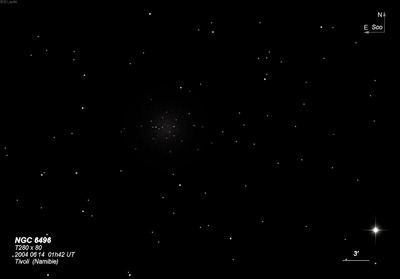
James Dunlop discovered NGC 6496 = D 460 = h3715 on 28 Jun 1826 and described "a very faint nebula, extended about 2 1/4' in length, oblique to the equator, with a bright point in each extremity; the northern, I think, is a very small star; but the southern of the two, or the one at the southern extremity, is a small nucleus or condensation of the nebulous matter. This follows 16 Telescopii - Figure 19." His position is 12.5' northwest of the cluster -- a typical error. His sketch shows the globular elongated NW-SE, which is probably due to several brighter stars. Dunlop's position for D 461 is 4 minutes of RA further east and same declination, so this could be a clerical error.
John Herschel noted a possible equivalence with D 460 and D 461 and observed the cluster on two sweeps. On 1 Jun 1834 he logged "Cluster very rich, irregularly round, including to triangular; vglbM, 4' or 5' diam, with many large and small stars in it. Nebulous." Then 2 nights later he swept the area again and reported "a distinctly nebulous insulted group, mE, 2' long, 1.5' broad, many stars of considerable size, mixed."
200/250mm - 8" (6/19/82): faint, diffuse, two faint stars at edge. Located 24' ENE of mag 4.9 SAO 228562 on the Scorpius-Corona Australis border. This cluster is very far south (low elevation) from Northern California.
400/500mm - 18" (7/10/02 - Magellan Observatory, Australia): moderately bright, low surface brightness globular of 4'-5' diameter. The globular has a loose concentration class with only a little central condensation. About a dozen stars were resolved over the face although some of these may be superimposed foreground stars as the cluster is set in a very dense Milky Way star field. Three of the stars are 12th magnitude with the remainder mag 14-15. The globular straddles the Scorpius/Corona Australis border, ~25' following mag 4.8 yellow HD 163145.
Notes by Steve Gottlieb